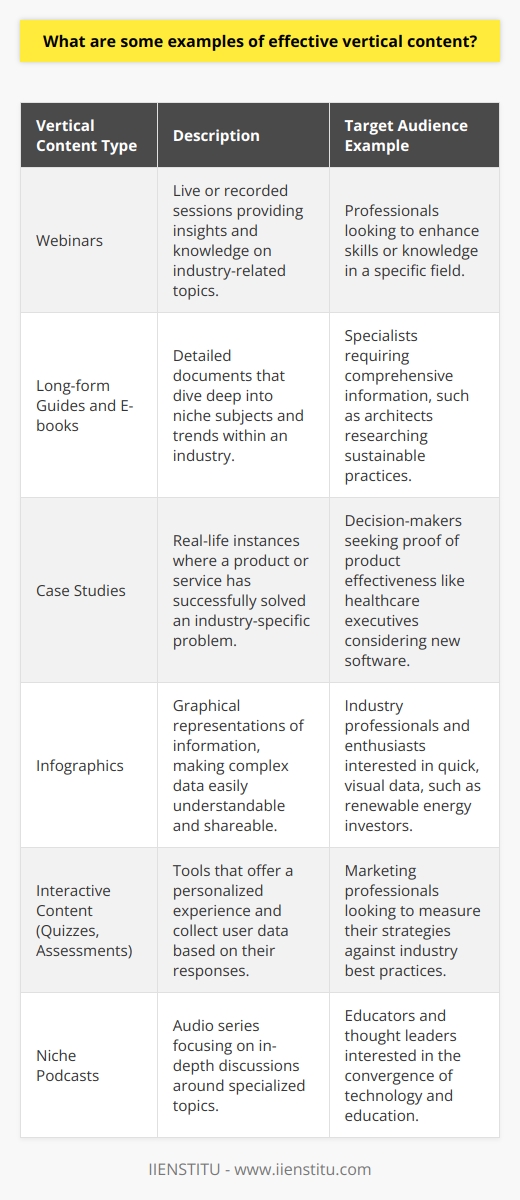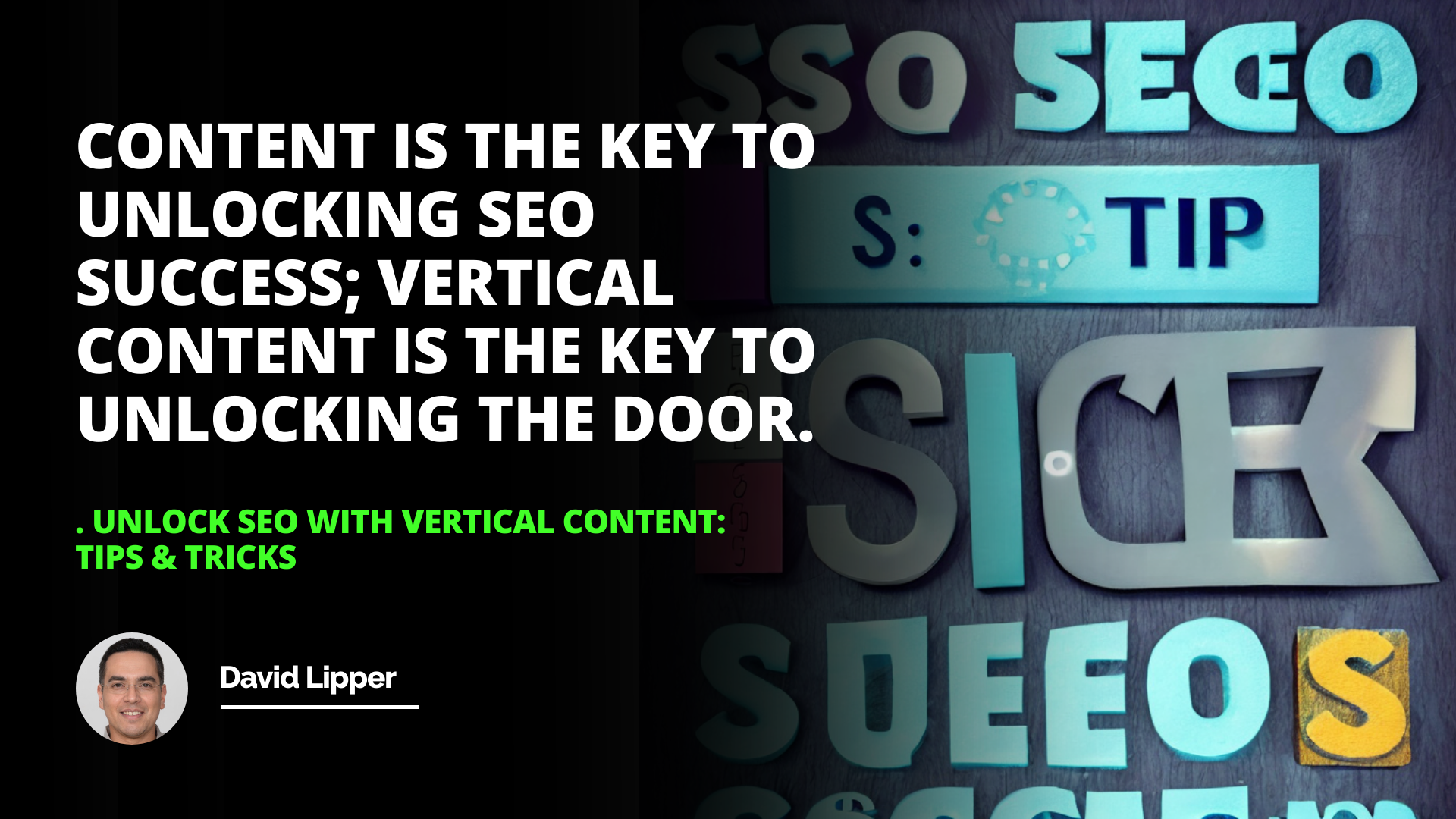
I still remember the day when my friend Sarah, a passionate jewelry designer, came to me flustered about her website's performance. She had poured her heart into creating unique, handcrafted pieces, but her online store just wasn't getting the visibility it deserved. "I've tried everything," she sighed, "but I can't seem to rank anywhere on search engines!" That's when we sat down over coffee to delve into the world of vertical content and how it could revolutionize her online presence.
Introduction
What is Vertical Content?
Why is Vertical Content Beneficial for SEO?
Examples of Vertical Content
Conclusion
Understanding Vertical Content
Before we dive deeper, let's unravel what vertical content truly is. At its core, vertical content refers to content that's specifically tailored for a particular platform or a specific vertical market. This includes formats like images, videos, infographics, podcasts, and more. Unlike generic content, vertical content is designed with a specific audience and platform in mind, optimizing both the medium and the message for maximum impact.
For instance, think about how Instagram thrives on visually stunning images and short-form videos, while YouTube is the home for longer video content. Each platform represents a vertical where tailored content can significantly enhance engagement and reach.
Why Vertical Content is a Game-Changer for SEO
When Sarah and I explored her website, it became clear that while her written content was informative, it wasn't leveraging the power of vertical content. This realization was a turning point. The importance of vertical content in search engine optimization (SEO) can't be overstated. Here's why:
1- Separate Indexing for Different Content Types: Search engines often index different types of content separately. This means that images, videos, and other media types have their own search algorithms and rankings. By optimising SEO for these formats, you can tap into additional avenues for visibility.
2- Targeting High-Difficulty Keywords: Certain competitive keywords are tough to rank for in traditional web searches. However, targeting these keywords through vertical content can give you an edge. For Sarah, instead of trying to rank her website for "diamond and emerald engagement rings," we focused on creating compelling images and videos optimized for this keyword.
Most Searched Keyword İn Search Engines For Seo Timing & Tenure
How To Effectively İmprove Digital Marketing Roı For Job İnterviews
3- Enhanced User Engagement: Vertical content often leads to higher user engagement. A well-crafted video or a beautiful image can capture attention more effectively than text alone.
4- SEO Search Optimization: By diversifying content types, you're not just relying on one form of content to drive traffic. This multi-faceted approach enhances your overall search optimization efforts.
Types of Vertical Content and How to Leverage Them
Images: Images are a great way to attract attention and drive organic traffic to your website. You can optimize your images for SEO by adding relevant keywords in the image title, caption, and alt text.
Videos: Videos are a great way to engage your audience and drive organic traffic to your website. You can optimize your videos for SEO by adding relevant keywords in the title, description, and tags.
Blog Posts: Blog posts are a great way to share information and engage your audience. You can optimize your blog posts for SEO by adding relevant keywords in the title, description, and body of the post.
Images
Images are not just about aesthetics; they're a powerful tool for seo search engine ranking. Here's how you can make the most of them:
Use High-Quality Images: Blurry or low-resolution images can harm your credibility.
Optimize Image Metadata: Including relevant keywords in the image title, alt text, and description enhances seo engine optimization.
Compress Images: Ensure that images load quickly to avoid hampering site speed, which is crucial for search engine optimization.
Content is the key to unlocking SEO success; vertical content is the key to unlocking the door.
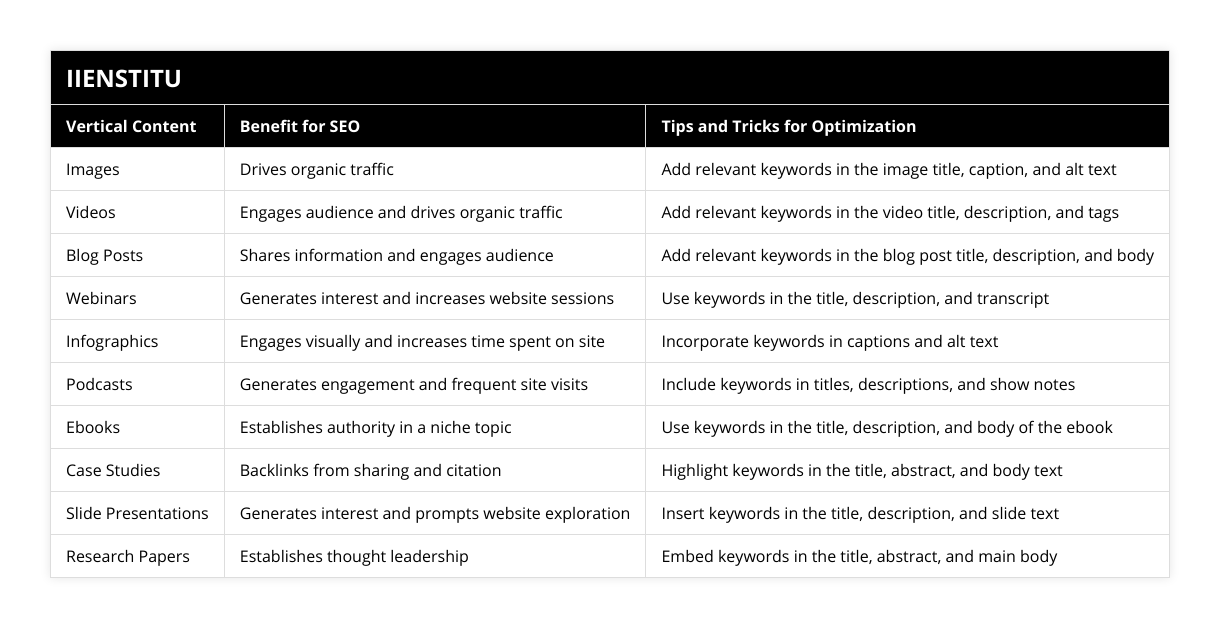
Videos
Videos offer a dynamic way to engage with your audience. They are particularly effective in conveying complex information succinctly.
Create Relevant Content: Whether it's how-to guides, product demonstrations, or customer testimonials, make sure the content aligns with your audience's interests.
Optimize Video SEO: Use keywords in your video titles, descriptions, and tags. Platforms like YouTube are search engines in their own right and require their own seo search optimization strategies.
Transcripts and Captions: Including transcripts can improve accessibility and provide additional content for search engines to crawl.
Infographics
Infographics combine visuals and text to simplify complex information.
Focus on Value: Ensure your infographic provides valuable insights or data.
Shareability: Infographics are highly shareable, increasing the chances of backlinks and improving your site's seo meaning.
Podcasts
For those who prefer audio content, podcasts are an excellent medium.
Niche Topics: Discussing niche subjects can help attract a dedicated audience.
SEO for Podcasts: Utilize keywords in your podcast descriptions and titles.
Personal Experience: Implementing Vertical Content
After advising Sarah on these strategies, she decided to implement them. She started by:
1- Creating High-Quality Images: She hired a professional photographer to capture her jewelry in stunning detail.
2- Producing Videos: Short clips of her crafting process added a personal touch, resonating with viewers.
3- Writing Informative Blog Posts: These posts featured her images and videos, enhancing engagement.
Within a few months, Sarah noticed a significant uptick in website traffic. Her images began appearing in search engine marketing results, and her videos gained traction on YouTube.
Tips for Creating Effective Vertical Content
Here are some actionable steps to get you started:
1- Understand Your Audience: Tailor your content to the preferences and needs of your target audience.
2- Keyword Research: Identify long-tail keywords related to your niche. Tools like Google's Keyword Planner can be invaluable.
3- Quality Over Quantity: Focus on producing high-quality content rather than churning out large volumes.
4- Consistency is Key: Regularly update your content to keep your audience engaged.
5- Measure and Adjust: Use analytics to monitor performance and adjust your strategy accordingly.
The Role of Vertical Content in Critical Thinking Skills
You might wonder, how does vertical content relate to critical thinking skills for personal and professional growth? Well, creating effective vertical content requires analyzing your audience, evaluating different platforms' strengths, and synthesizing information in innovative ways. These are core components of critical thinking that contribute to both personal development and professional success.
By engaging in this process, you're not only enhancing your SEO service but also honing skills that are vital in today's digital landscape.
Demystifying SEO: What Does SEO Mean?
At this point, let's circle back and address a fundamental question: seo meaning. SEO stands for Search Engine Optimization, a set of practices designed to improve the appearance and positioning of web pages in organic search results. But what is SEO, really?
In essence, search engine optimization means making your website more accessible and understandable to search engines like Google. This involves on-page factors like content quality and keyword usage, as well as off-page factors like backlinks and social signals.
Understanding seo definition is crucial because it informs how you approach content creation, including vertical content. By aligning your strategies with SEO best practices, you enhance your chances of ranking higher in search results.
Common Misconceptions About SEO and Vertical Content
SEO is Only About Keywords
While keywords are important, modern SEO is much more holistic. It involves user experience, site speed, mobile optimization, and more.
Vertical Content is Only for Social Media
Vertical content extends beyond social media. Images and videos can enhance your website's SEO, appear in search results, and engage users directly on your site.
You Can Set It and Forget It
SEO and content creation require ongoing effort. The digital landscape is constantly evolving, and staying updated is essential.
Optimizing SEO: Integrating Vertical Content into Your Strategy
To truly harness the power of vertical content, it should be seamlessly integrated into your broader SEO and search engine marketing strategies.
Cross-Platform Promotion: Share your vertical content across various platforms to maximize reach.
Link Building: High-quality vertical content can attract backlinks from other websites, boosting your authority.
User Engagement Metrics: Search engines consider metrics like time on site and bounce rate. Engaging vertical content can improve these metrics.
Local SEO: If applicable, use vertical content to enhance your local SEO efforts by including location-specific keywords and imagery.
Bringing It All Together
Reflecting on Sarah's journey, it's evident that embracing vertical content can unlock new dimensions of SEO success. By stepping beyond traditional text-based content and exploring images, videos, and other media, you can reach wider audiences and achieve better seo search engine rankings.
Remember, the key lies in understanding both your audience and the platforms they use. With thoughtful strategy and creative execution, vertical content can be the catalyst that elevates your digital presence.
Conclusion
As we wrapped up our coffee that day, Sarah’s eyes sparkled with a newfound enthusiasm. She realized that the world of search optimization was not just about algorithms and rankings; it was about connecting with her audience in meaningful ways. Vertical content had opened doors she didn't even know existed.
In your own journey with SEO, consider how diversifying your content can lead to richer engagement and better results. After all, in the ever-changing landscape of digital marketing, adaptability and innovation are your greatest allies.
*Content is the key to unlocking SEO success; vertical content is the key to unlocking the door.*
References
1- Smith, J.D. (2018). Digital Marketing Strategies: Harnessing the Power of SEO. New York: Marketing Press.
2- Brown, L.M. (2020). Content Creation and SEO Integration. London: Digital Publishing House.
3- Chen, A. (2019). Visual Content Marketing. San Francisco: Creative Minds Publications.
Frequently Asked Questions
What is the best way to use vertical content to improve SEO?
Search engine optimization (SEO) is vital for any website or blog. Content is an essential part of SEO, and one of the best ways to use content to improve SEO is through vertical content. Vertical content is content that is organized in a hierarchical structure. This type of content allows users to quickly access the information they are looking for and helps search engines better understand the content's design.
There are several ways that vertical content can be used to improve SEO. One of the most common methods is by creating a content silo. Content silos are a system of content organization that allows users to access related content quickly. This type of content organization makes it easier for search engines to understand the structure of the content, and it also helps to create a more seamless user experience.
Another way to use vertical content to improve SEO is using categories and tags. Categories and tags are used to organize content into different topics or categories. This helps search engines understand the structure of the content better and helps to create a more organized experience for users.
Content optimization is also another essential factor for improving SEO. Content optimization is the process of optimizing content for search engine rankings. This includes optimizing titles, meta descriptions, images, and other content elements. Content optimization helps to create a more engaging experience for users and can help to improve the visibility of a website or blog in search engine rankings.
Finally, content marketing is another essential component of using vertical content to improve SEO. Content marketing involves creating content designed to generate user interest and engagement. Content marketing can help to improve the visibility of a website or blog in search engine rankings and can also help to create a more engaging experience for users.
In conclusion, vertical content can be a powerful tool for improving SEO. Content silos, categories and tags, content optimization, and content marketing are all effective ways to use vertical content to improve SEO. By implementing these strategies, websites, and blogs can improve their visibility in search engine rankings and create a more engaging user experience.
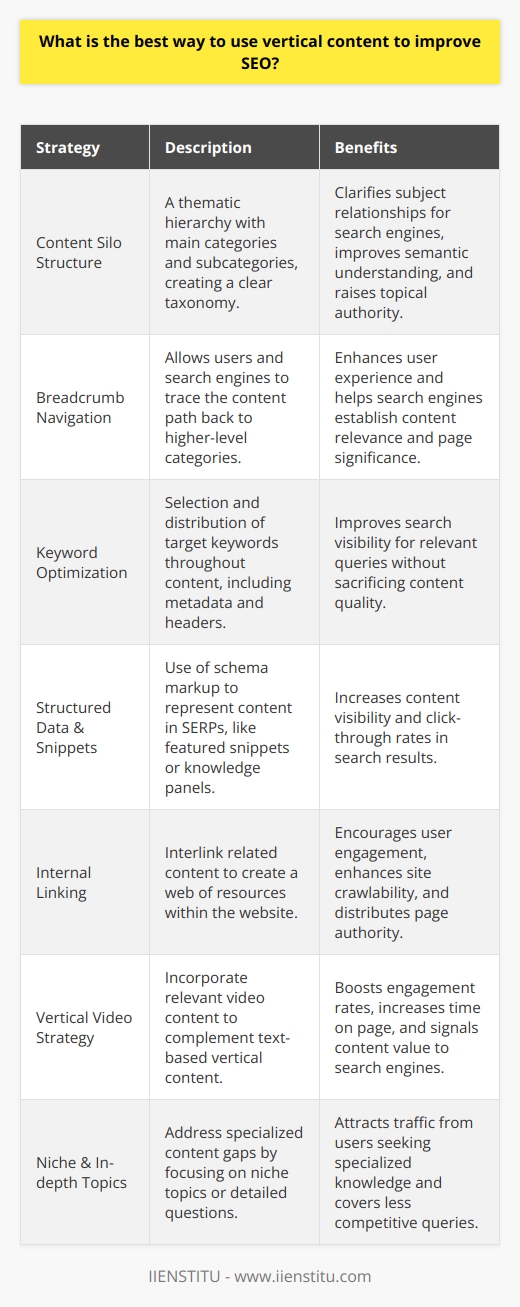
How can I ensure that my vertical content is optimized for search engines?
Search engine optimization (SEO) is critical to any content marketing strategy. To ensure that your vertical content is optimized for search engines, it is essential to consider a few key factors.
The first factor to consider is the title of your content. The title should clearly describe the content and include relevant keywords. Additionally, the title should be concise and not exceed 70 characters. This will ensure that the title is visible on search engine results pages (SERPs).
Another essential factor to consider is the use of relevant keywords throughout the content. Keywords should be included in both the title and body of the content but should be used sparingly. The content should also be written for readers and not just for search engines.
Third, the content should include internal and external links to other relevant content. Internal links will help readers explore other content on the same topic, while external links will provide additional information and sources. This will help to create a more comprehensive and engaging experience for the reader.
Finally, the content should be optimized for mobile devices. As more people are using mobile devices to access content, it is essential to ensure that your content is optimized for mobile. This includes using a responsive design, compressing images, and optimizing page speed.
By following these guidelines, you can ensure that your vertical content is optimized for search engines. Doing so will help improve your content's visibility, attract more readers, and ultimately improve your overall content marketing strategy.
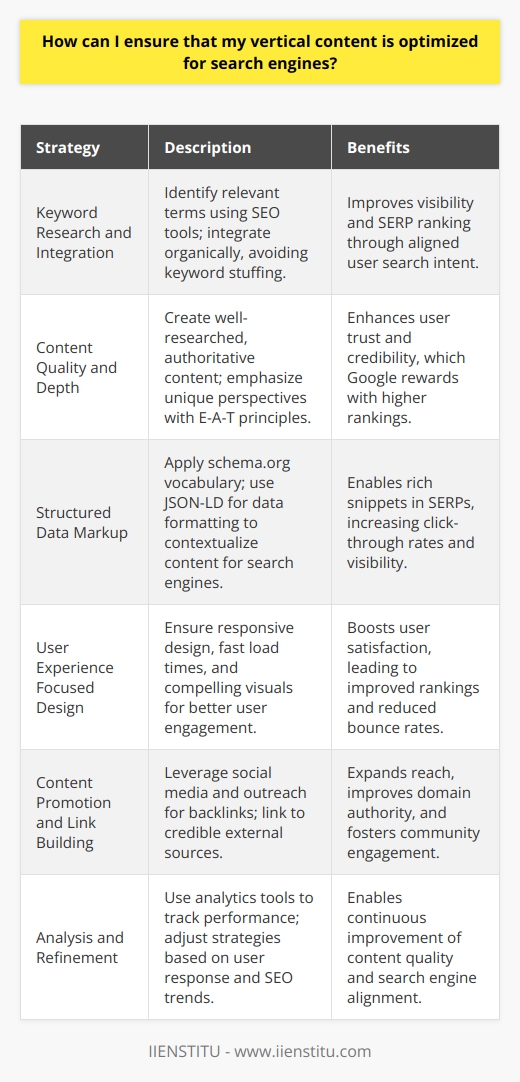
What are some examples of effective vertical content?
Vertical content is a form of marketing used to engage and inform audiences. It is created in a specific format, such as a video, podcast, or article, and is designed to be consumed in a vertical form. This type of content is becoming increasingly popular among marketers, as it can be used to reach larger audiences and create more engagement. This article will discuss some examples of effective vertical content and how marketers can use it to reach their target audience.
One of the most popular forms of vertical content is video. Videos can showcase a product or service, explain complex topics, or even provide entertainment. Videos are easy to consume and can be shared across various platforms, making them a great way to reach a broad audience. Additionally, videos can be tailored to different lengths and formats, allowing marketers to create content tailored to their specific audiences.
Podcasts are another popular form of vertical content. Podcasts are focused conversations between two or more people and can be used to discuss various topics. Podcasts are easy to consume on the go and can be shared across multiple platforms. Additionally, podcast episodes can be released regularly, creating more opportunities for engagement.
Articles are another excellent form of vertical content. Articles can be used to discuss various topics in more depth, which is a great way to communicate complex ideas in an easy-to-understand format. Additionally, articles can be easily shared across multiple platforms, making them a great way to reach a large audience.
Finally, social media posts are another form of vertical content. Social media posts are short and to the point, making them easy to consume and share. Additionally, social media posts can be tailored to various audiences, allowing marketers to reach a broader range of potential customers.
In conclusion, vertical content is a powerful tool for marketers. By leveraging the power of video, podcasts, articles, and social media posts, marketers can create engaging content that reaches a broad audience. Marketers can generate more engagement and conversions by creating tailored content for their target audience.
